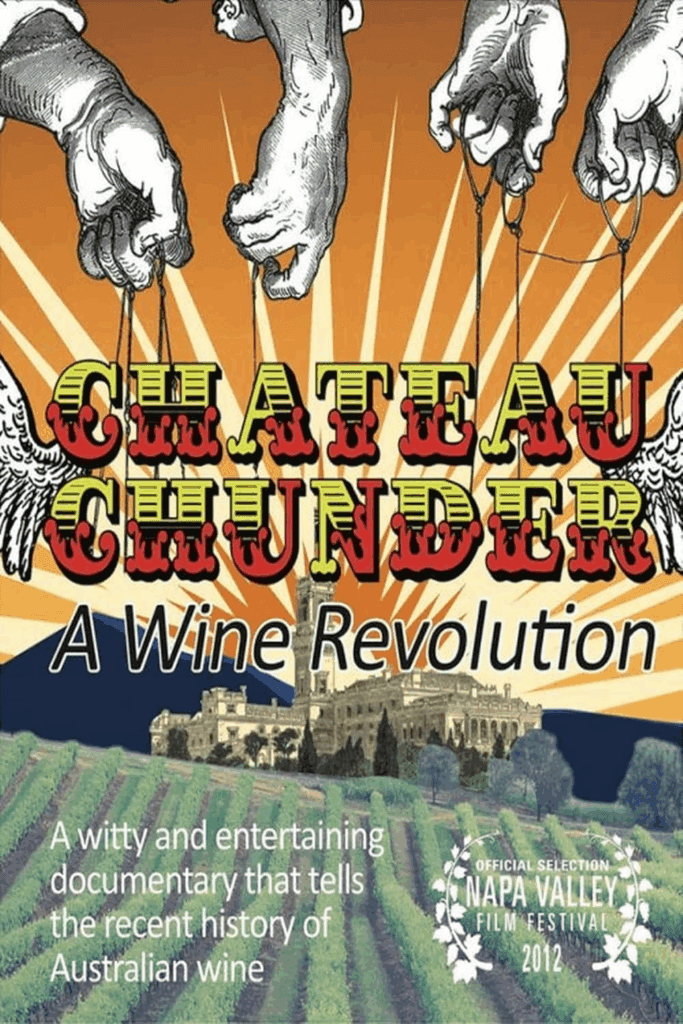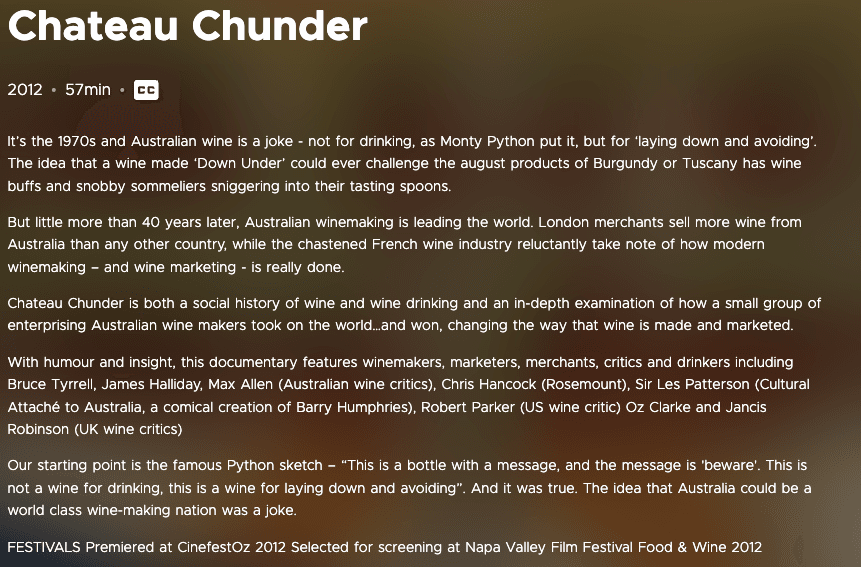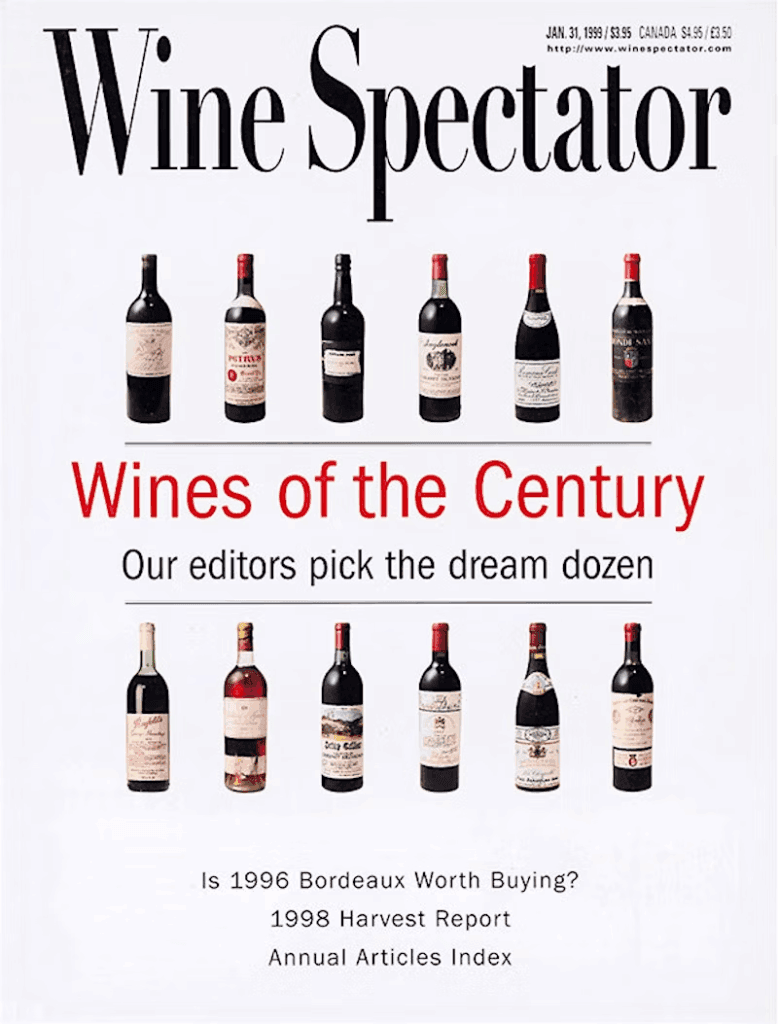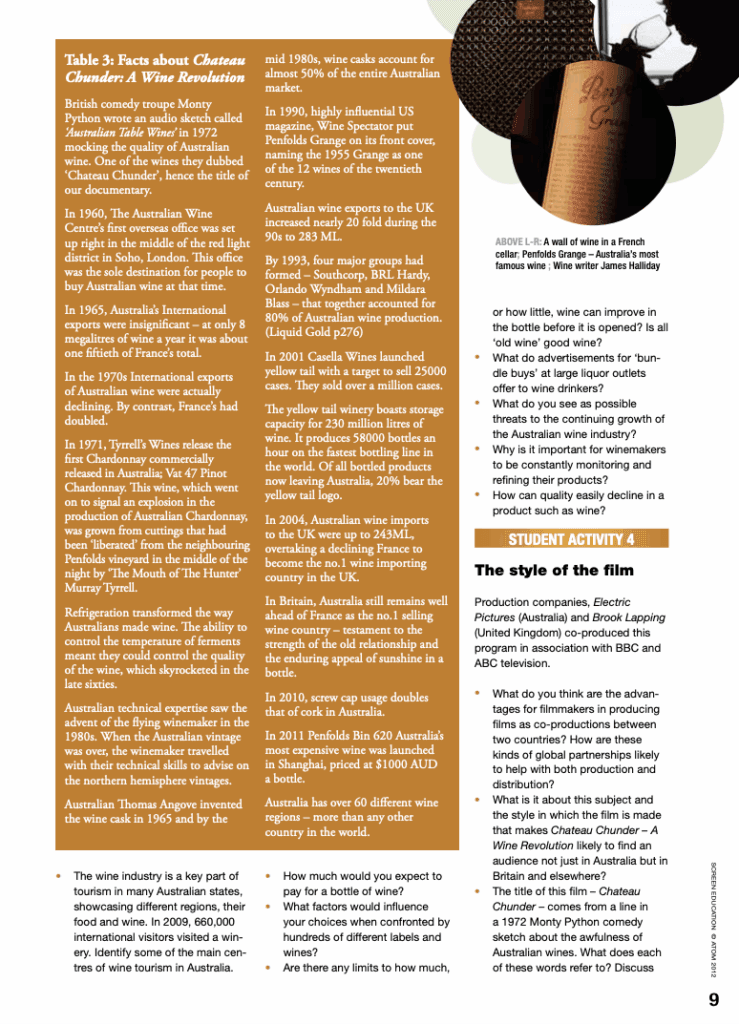
| Title | Chateau Chunder: A Wine Revolution |
| Director | Stephen Oliver |
| Synopsis | A documentary on the recent history of Australian wine, revealing how a small group of enterprising Australian winemakers took on the elitist world of wine – and won. |
| Release | October, 2012 |
| IMDB | www.imdb.com/title/tt2551436 |
| Length | 57m |
| Website | www.kanopy.com/en/product/255492 |
| YouTube | Chateau Chunder |
About the Film

Reviews
- Chateau Chunder, a new film about Australian wine, Chris Mercer, Decanter 2012
- Chateau Chunder, an interesting documentary about Australian wine reviewed, Jamie Goode, Wine Anorak 2012
- Chateau Chunder revisited, Henry Jeffreys, Drinking Culture (Substack), 2025
Trailer
From Chateau Chunder to Terroir:
The Story of Australian Wine’s Rise
Prologue & Reputation
The saga begins in the 1970s, when Australian wine was the punchline for jokes worldwide—thanks, in part, to Monty Python. In their audio sketch from 1972, they delivered memorable lines that would haunt winemakers for years.
This is a bottle with a message in and the message is beware because it’s not a wine for drinking, this is a wine for laying down and avoiding.
For decades, Australian wine simply wasn’t on the global map—except as fortified, “medicinal” exports. Its reputation was summed up by one word: avoid.

Old World Versus New World—Terroir
French winemaking is steeped in history, agronomy, and terroir: the mystical marriage of soil and climate. Meanwhile, Australian wine culture developed with a more practical approach. Michel Chapoutier and Laure Colombo articulate the difference: France evolves through tradition; Australia through innovation.
Drinking Culture & Early Winemakers
Australia’s beer culture loomed large. Wine was for eccentrics, “queer,” or simply the “dregs of society.” Pioneers like the Tyrrells and Hill Smiths struggled against social stigma.
“In the 1950s and early 60s if you drank table wine you were queer, or eccentric, or both. I had a girlfriend from university, from a country town, and her parents weren’t sure I was a suitable person because I was a plonkie.”
—Bruce Tyrell
“People used to say that: wine is not for the likes of us.”
—Oz Clarke
With little domestic market, exports seemed the only hope—but even in Britain, wine was for the privileged.
Table Wine & Social Change
Immigration, rising affluence, and travel began changing Australia’s palate by the 1970s. A new appreciation for food and wine paved the way for domestic success and wine tourism.
For all the things my old man did, probably the most important one is he’s really the father of wine tourism in Australia
—Bruce Tyrrell
Science of Winemaking
Technical advances—from fermentation control to refrigeration—rebuilt Australian wine from the inside out.
So the quality of Australian wine in the sixties just skyrocketed
—Bruce Tyrrell
Yet, by 1965, exports remained a fraction of France’s massive output.
Overseas Expansion, Branding & Blind Tasting
Australian winemakers turned to the UK, facing skepticism but winning hearts through daring new branding and the “blind tasting” revolution.
Kanga Rouge 1978: if people laugh about this, they don’t know what they are talking about.
—Oz Clarke
Len Evans’ legendary tutorial and advocates like Robert Joseph redefined how the world thought about Australian wine.

Hazel Murphy & UK Market Breakthrough
Hazel Murphy’s bold marketing in the UK marked a turning point. Australian producers asked British consumers what they liked and adjusted their wines and labels accordingly.
Australians made wine that we wanted and asked us what we liked—that had never happened in the world of wine before.
—Oz Clarke
A French wine, you always had to know about geography and a bit of history, and also have a bit of luck to get a decent wine.
—Oz Clarke
EU bans on European-sounding names led Australia’s shift to varietal labeling—a door opener for the global market.
Australian Lifestyle Marketing, Media & Wine Democratization
Aussie winemakers mastered the art of lifestyle branding, and TV hosts like Oz Clarke and Jilly Goolden democratized wine language for everyone.
Marketing was the great black art that Australia had mastered and the French did not place any importance in marketing. They thought the product would speak for itself and they thought we were hoodwinking the world with our clever marketing – Huon Hook
Inventions, Casks, Corks & Export Boom
Australia’s “goon bag” (wine cask) revolutionized drinking habits, while exports boomed. Screw caps (stelvin) replaced corks, shocking the French.
Screw caps is probably the last Waterloo for the French
—George Dos Santos
French Resistance & International Recognition
Despite militant backlash (CRAV), Australia’s top wines won global acclaim. Penfolds Grange was named one of the 12 wines of the 20th century, with critics like Robert Joseph and Parker affirming its status.
- Putting Grange back on the map, Jancis Robinson, Oct 2008, JancisRobinson.com

US Market—Parker, Yellowtail, Globalization
Robert Parker’s enthusiastic advocacy, the rise of Yellowtail, and waves of global investment propelled Australia to new heights—but consolidation posed challenges.
Robert Parker to some extent launched Australian wine to the US market and made the Barossa famous. Those big Barossa reds got 100 out of 100 and suddenly went from 10 dollars to 200 dollars a bottle.
—Bruce Tyrell
Crisis, Reorientation & Terroir Rediscovered
Oversupply led to a loss of reputation—Chardonnay the “loser’s choice”—but a renewed focus on quality, regionality, and terroir is driving the next generation.
You can’t imagine how much I have learned in Australia. Australia was in the 21st century when France was still in the 19th century.
—Michel Chapoutier
Australian wine has gone from Chateau Chunder to Sunshine in a bottle to the mystery of terroir in a single generation.
Wineries
Tyrrell’s
One of Australia’s most historic wineries, founded in 1858 and still family-run. Tyrrell’s is renowned for classic Hunter Valley Semillon and Shiraz, with some of Australia’s oldest vines. The estate’s focus on traditional winemaking and terroir showcases the region’s unique style.
Hill Smith Family Estates
The family behind Yalumba, one of Australia’s oldest independent wineries, with deep roots in the Barossa Valley. Hill Smiths have championed innovation, quality, and sustainable practices, building major brands in both the premium and value segments.
Rosemount Estate (Treasury Wine Estates)
Established in 1969, Rosemount quickly became a major force in modern Australian wine, famous for its approachable, fruit-forward styles like Chardonnay and blends. The brand helped popularize “sunshine in a bottle” and was one of the top-selling Australian names internationally, especially in the US.
Torbreck Vintners
Based in the Barossa Valley, Torbreck specializes in powerful, Rhône-inspired wines from ancient vines. Known for bold Shiraz, Grenache, and blends, Torbreck’s attention to tradition and low yields produce some of Australia’s most luxurious and collectible wines.
Penfolds (Treasury Wine Estates)
Founded in 1844, Penfolds is Australia’s most iconic producer. Its flagship wine, Grange, set the global standard for Australian red wine—deep, ageworthy Shiraz blends—now regularly praised as one of the world’s great wines.
Yellowtail (Casella Family Brands)
Launched in 2001 by the Casella family, Yellowtail revolutionized global wine markets with approachable, value-focused brands. The label is famous for its simple, fruity style, rapid sales growth, and mass appeal in the US and worldwide.
Jacob’s Creek (Vinarchy)
Established in 1976 in the Barossa Valley, Jacob’s Creek is one of Australia’s most recognized brands globally. Known for approachable wines and broad variety, the brand represents easy-drinking styles that helped shape the nation’s export success.
Cullen Wines
Located in Margaret River, Western Australia, Cullen Wines is celebrated for biodynamic practices and exceptional Cabernet Sauvignon and Chardonnay. Family-owned and visionary, Cullen is a leader in sustainable viticulture and fine wine.
Orlando (bag-in-box cask):
Orlando wine pioneered the wine cask (bag-in-box) packaging innovation, making wine more accessible and convenient in Australia and beyond. Orlando also produces traditional bottled wines, but is best remembered for the “goon bag” breakthrough.
Chapoutier (France/Australia):
Michel Chapoutier, famed Rhône Valley producer, extended his wine interests to Australia, bringing French expertise to local vineyards and helping bridge Old World philosophies with New World terroir. Chapoutier’s Australian wines combine French tradition and Australian innovation.
Winemakers
Bruce Tyrrell, Tyrell’s Wines (Hunter Valley, Australia)
Fourth-generation winemaker and Managing Director of Tyrell’s, one of Australia’s oldest family wineries, founded in 1858. Bruce is famed for Hunter Valley Semillon and his dedication to promoting family-run wine business and vineyard heritage. He’s noted for innovative vintage releases and received an Order of Australia medal for contributions to the industry.
Chris Hancock, Rosemount Estate (Australia)
Veteran winemaker and executive, Chris Hancock shaped Rosemount’s global reputation, having joined in 1976. He’s produced notable vintages at Penfolds and guided Rosemount’s international expansion. Now Deputy Executive Chairman of Robert Oatley Vineyards, Chris also launched Hancock & Hancock wines in McLaren Vale.
Robert Hill Smith, Yalumba (Eden Valley, Australia)
Fifth-generation owner and Managing Director of Yalumba, Australia’s oldest family winery. Robert spearheaded Yalumba’s shift to table wine, promoted Viognier nationwide, and formed Australia’s First Families of Wine collective. Known for innovation, family business leadership, and preserving Yalumba traditions.
David Powell, Torbreck Wines (Barossa Valley, Australia)
Founder of Torbreck in 1994, David Powell is renowned for crafting iconic, Rhône-style wines from old Barossa vines, notably “RunRig.” His self-taught, maverick approach and colorful persona helped elevate Torbreck’s international profile. After leaving Torbreck, Powell established Powell & Son with his son Callum.
John Casella, Yellowtail (Riverina/Yenda, Australia)
Managing Director of Casella Family Brands, John Casella transformed Yellow Tail into one of the world’s most recognized wine brands. He pioneered approachable, fruit-forward wines tailored to global markets, and under his leadership, Yellow Tail became Australia’s largest family-owned winery.
- Winery to refinery: How John Casella built Yellow Tail into a billion-dollar empire, Forbes 2025
- www.yellowtailwine.com
Michel Chapoutier, Maison M. Chapoutier (Hermitage, Rhône, France)
Visionary winemaker, Michel Chapoutier took over his family’s historic Hermitage winery in the late 1980s. He is celebrated for site-specific, single-vineyard wines, converting vineyards to biodynamic farming, and introducing braille on labels. Chapoutier is considered a pioneering force in the Rhône Valley.
Laure & Jean Luc Colombo, Vins Colombo (Cornas, Rhône, France)
Jean-Luc Colombo is a trail-blazing Rhône winemaker and wine consultant, credited with revitalizing the Cornas AOC through focus on site expression and organic viticulture. Laure Colombo, his daughter, is head winemaker at Vins Colombo, noted for her independent vision and sustainable practices. Together, they produce acclaimed Syrah and Rhône blends.
Phil Laffer, Jacob’s Creek (Barossa Valley, Australia)
Longtime Chief Winemaker at Jacob’s Creek, part of Orlando-Wyndham, Phil Laffer helped improve the reputation of Australian value wines worldwide. He’s lauded for winemaking innovation and for shaping Jacob’s Creek into a globally recognized brand.
Peter Gago, Penfolds (South Australia)
Since 2002, Peter Gago has been Chief Winemaker and “custodian” of Penfolds Grange, Australia’s most iconic wine. British-born, Gago joined Penfolds in 1989 and is an advocate of minimal intervention winemaking. He’s a respected speaker, author, and one of Australia’s most decorated contemporary winemakers.
Vanya Cullen, Cullen Wines (Margaret River, Australia)
Managing Director and Chief Winemaker since 1989, Vanya Cullen has led her family’s pioneering organic and biodynamic Margaret River estate to international acclaim. She’s known for her environmental innovations, advocacy for sustainability, and benchmark Cabernet blends—winning numerous awards including “Australian Winemaker of the Year”
Wine Writers & Personalities
Jancis Robinson John Avery MW, Averys of Bristol Alun Griffiths MW, Wine Merchant, Berry Bros. & Rudd Hazel Murphy Jilly Goolden [David Lowe,](https://en.wikipedia.org/wiki/David_Lowe_(winemaker)) Small Winemakers Assoc. Len Evans (1930-2006),
Max Allen
Australian wine writer, journalist, and lecturer at the University of Melbourne. Max Allen is known for accessible, entertaining writing and is the wine and drinks columnist for the Australian Financial Review and contributor to Gourmet Traveller Magazine. He is recognized for exploring the changing face of Australian wine, authoring books like Alternative Reality: How Australian Wine Changed Course.
Oz Clarke
A highly influential British wine writer, broadcaster, and TV presenter renowned for his wit and palate. Clarke is credited with popularizing wine for the masses in the UK through books and television (notably BBC’s Food and Drink). He has received multiple leading wine communication awards and is considered the UK’s best-known wine critic.
Jilly Goolden
English wine critic, journalist, and TV presenter. Best known as Oz Clarke’s co-presenter on BBC2’s Food and Drink, Goolden is famous for her vivid, sometimes eccentric, tasting notes and for making wine appreciation more accessible to the public.
Huon Hooke
Australian independent wine writer, journalist, judge, and educator. Hooke has written for the Sydney Morning Herald, Gourmet Traveller Wine, and numerous other publications. He is a respected competition judge in Australia and internationally, and author of influential guides and biographies, such as Max Schubert, Winemaker.
Robert Joseph
British wine writer, industry analyst, and innovator, founder of the International Wine Challenge and Wine International magazine. Joseph was Sunday Telegraph’s wine correspondent for 16 years and is also known for his international wine consultancy, wine branding (co-founder of Le Grand Noir), and as author of more than 28 books. He’s recognized for both critical and entrepreneurial contributions to wine.
Jancis Robinson
Globally acclaimed British wine critic, journalist, author, and Master of Wine. Editor of The Oxford Companion to Wine and co-author of The World Atlas of Wine, Robinson is known for her detailed, encyclopedic coverage and educational outreach. She is voted among the world’s most influential wine critics and regularly writes for her own site jancisrobinson.com.
John Avery MW
Member of the Avery wine merchant family (“Averys of Bristol”), Master of Wine, and leading figure in UK wine retail. He was a key champion of Australian wine in the UK and played a major role in introducing new world wines to British consumers.
Alun Griffiths MW
Master of Wine, former Wine Director at Berry Bros. & Rudd, one of the UK’s top wine merchants. Recognized for his expertise in fine wine buying, tasting, and education, Griffiths played a significant role in shaping the UK market’s approach to global wines
Hazel Murphy
Dynamic wine marketer, notably the Australian Wine Bureau’s UK Manager. She was instrumental in the explosive growth of Australian wine in the UK in the 1980s and 90s through pioneering tastings, direct marketing, and engagement with consumers.
David Lowe
Australian winemaker (see Small Winemakers Association), consultant, and advocate for boutique wine producers. Known for his industry leadership, technical expertise, and support of small producers
Len Evans (1930–2006)
Legendary Australian wine writer, educator, critic, and industry leader. Evans championed blind tasting and promoted quality winemaking in Australia, creating lasting educational legacies like the Len Evans Tutorial.
Other
- Germaine Greer, Prof. Literature, Warwich University
- David Dunstan, Historian, Monash University
- Lisa Hilton, Social Historian
- Allan, Cheesman, Wine Buyer, Sainsbury’s
- Andrew Hoyne, Wine Label Designer
- Tony Proctor & Roddy Kane, Barramundi Wines
References
- Australia’s wine history is only just over 200 years young – Wine Guide Australia
- Australian Wine | wikipedia
- The Evolution of Australian wine, Jamie Goode, Wine Australia, 2017
- Wine Australia Market update: United Kingdom September 2024 (PDF)
- The Australian Ark: The storied history of Australia’s pre-phylloxera grapevines, Andrew Caillard, The World of Fine Wine, 2024
Bonus
There is a study guide


Comments
One response to “Film Notes: Chateau Chunder (2012)”
[…] Film Notes: Chateau Chunder (2012) […]